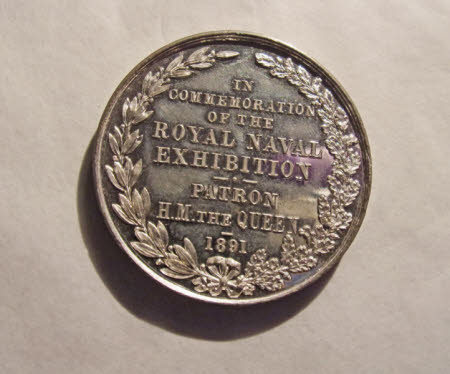The Royal Naval Exhibition medal
Alfred E. Warner (fl. 1890 - 1916)
Category
Coins and medals
Date
1891
Materials
Metal
Measurements
3 mm (Height); 37 mm (Diameter)
Place of origin
London
Order this imageCollection
Ickworth, Suffolk
NT 849225
Summary
Sculpture, silver; commemorative medal for the Royal Naval Exhibition, London 1891; A.E. Warner; London, 1891. The Royal Naval exhibition, which ran for six months in 1891 in Chelsea, London, aimed to show the public the development of the navy from its earliest beginnings to the present day. The exhibition was an enormous success, attracting more than 2 million visits over six months. The medal contrasts historic and modern ships, H.M.S. Victory and Camperdown, whilst also featuring prominently the Eddystone Lighthouse, a full-sized replica of which was among the star exhibits at the exhibition.
Full description
A commemorative medal in silver for the 1891 Royal Naval exhibition held in Chelsea in London. The obverse has the commemorative inscription within an open wreath, whilst on the reverse is the Eddystone Lighthouse in the centre, to the left H.M.S. Victory and, to the right, the modern vessel H.M.S. Camperdown. Signed on the exergue rail on the reverse. The medal was made to celebrate the Royal Naval Exhibition, held in Chelsea and organized on the back of the success of a military exhibition held in the previous year. Like the earlier show, the aim of the naval exhibition was to show the public the development of the service, from its earliest beginnings to modern times, through a chronologically-organized series of exhibits, paintings and relics. Among the star exhibits was a full-sized replica of the Eddystone Lighthouse, off Rame Head in Cornwall, which had been recently rebuilt in the 1880s. The exhibition was opened on 2 May 1891 by the Prince and Princess of Wales, accompanied by other members of the royal family. The exhibition, any surplus funds from which were to be given to naval widows and orphans, was a great success, with more than 8,000 visitors on the first day and 2.25 million visitors over the six months that it was open. This is the only medal currently known to have been made by Alfred E. Warner, who was a London-based die-sinker, seal and gem engraver. The medal was issued in silver and white medal versions. The commemorative medals were sold in white cardboard boxes with a purple border around the lid, which was inscribed on the top R.N.E. 1891, with a crown above. Another silver example of the medal (NT 1340720) that still retains its box, with the artist’s address, 10 Wardour Street in Soho, is at Snowshill (NT 1341495). By 1916 Warner had moved to 36 Gerrard Street (Forrer, VI, p. 373). There is at the Argory a splendid engraved Exhibition diploma certificate (NT 564796) presented by the organizing committee of the exhibition to Captain Bond Shelton. Jeremy Warren October 2025
Provenance
Part of the Bristol Collection. Acquired by the National Trust in 1956 under the auspices of the National Land Fund, later the National Heritage Memorial Fund
Marks and inscriptions
Obverse Legend: IN / COMMEMORATION / OF THE / ROYAL NAVAL / EXHIBITION // PATRON / H.M. / THE QUEEN / 1891 Reverse legend: In exergue: Left, H.M.S. VICTORY / 1805 Right, H.M.S. CAMPERDOWN / 1891 On exergue rail: A.E. WARNER / LONDON
Makers and roles
Alfred E. Warner (fl. 1890 - 1916), sculptor
References
Forrer 1904-30: Leonard Forrer, Biographical Dictionary of medallists : coin, gem, and seal-engravers, mint-masters, etc., ancient and modern, with references to their works B.C. 500-A.D. 1900, 8 vols., London 1904-30 Milford Haven 1919: Admiral the Marquess of Milford Haven, British Naval Medals, London 1919, p.432, no.811 Brown 1987: Laurence Brown, British Historical Medals 1837-1901. The Reign of Queen Victoria, London 1987, p. 406, no. 3419 Whittlestone and Ewing 2008: Andrew Whittlestone and Michael Ewing, Royal Commemorative Medals 1837-1977. I. The Reign of Queen Victoria 1837-1901, Llanfyllin 2008, p. 141, no. 1659. Eimer 2010: Christopher Eimer, British Commemorative Medals and their Values, London 2010, p. 233, no. 1767.

